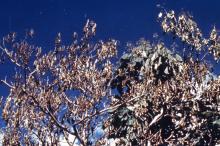See:
Maple (Acer spp.) - Verticillium Wilt
Cause Verticillium dahliae, a fungus. Although there is no published report from the Pacific Northwest, OSU Plant Clinic has found the disease on Catalpa several times in Oregon. Trees planted near streets are reportedly very susceptible. The fungus survives for long periods in soil and is not easily controlled. The fungus grows into the xylem where it colonizes the plant through mycelial growth and conidial production. Conidia are transported passively by the fluid movement in the xylem. Once in the xylem, this fungus partially blocks water movement and produces toxins that result in wilt symptoms.
Symptoms Purplish to bluish brown streaks are found under bark in the sapwood of wilted branches. Wilting of leaves may occur on only one side of the tree. Trees may die back within a year or branch by branch over many years.
Sampling Send soil samples to any of various private and public laboratories to assay for Verticillium propagules. Nurseries may wish to test individual core samples to determine the distribution in a particular field. The presence of any microsclerotia in the soil should be interpreted as a potential disease risk.
Cultural control
- Fertilization may help if it is not applied too late in the year.
- Remove and destroy symptomatic or dead branches preferably before leaves fall and thus before new inoculum gets incorporated into the ground.
- Clean pruning equipment after use.
- If tree dies and/or is removed, replace with a nonsusceptible host such as any conifer, birch, dogwood, sycamore, or willow.
Chemical control A few chemicals are registered for tree injection. Trees are to be injected as a preventative treatment. Do not inject trees less than 2 inches in diameter or that are suffering from various stresses. Efficacy in the Pacific Northwest is unknown.
- Fungisol as specified on the label. Washington and Idaho only.
Reference Goud, J.C. and Termorshuizen, A.J. 2002. Pathogenicity and virulence of the two Dutch VCGs of Verticillium dahliae to woody ornamentals. European Journal of Plant Pathology 108:771-782.


